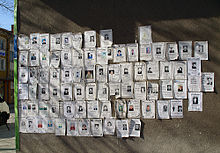Obituary: Difference between revisions
WhatamIdoing (talk | contribs) →Contents: YMMV |
→See also: commons |
||
| Line 42: | Line 42: | ||
== See also == |
== See also == |
||
{{Commons category|Obituaries}} |
{{Commons category|Obituaries}} |
||
{{Commons|Black obituary pictures}} |
|||
* [[Eulogy]] |
* [[Eulogy]] |
||
* [[Funeral]] |
* [[Funeral]] |
||
Revision as of 09:06, 27 April 2011
This article needs additional citations for verification. (October 2009) |


An obituary is a news story that reports the recent death of a person, typically along with an account of the person's life and information about the upcoming funeral.[1] In large cities and larger newspapers, obituaries are written only for people considered significant.[1] In local newspapers, an obituary may be published for any local resident upon death.
Two types of paid advertisements are related to obituaries. One, known as a death notice, omits most biographical details and may be a legally required public notice under some circumstances. The other type, a paid memorial advertisement, is usually written by family members or friends, perhaps with assistance from a funeral home.[1] Both types of paid advertisements are usually run as classified advertisements.
History
The first obituary is very difficult to trace, however many candidates are found at the advent and popularization of the printing press circa 16th century. The first obituaries were concise, simply containing the deceased name, birth date, death date, and cause of death, family that is surviving and those that died before them.
During the late 19th century John Thadeus Delane, an English editor of the London newspaper The Times, saw the potential for obituaries and began publishing them. This entailed newspapers recognizing a person's death as a solemn and important event that needed more than just a short announcement. As a result, obituaries grew in length and elaboration, containing short prayers, poems, and brief biographies.
At the onset of the 20th century modern advances in printing technology allowed obituaries to contain images; this allowed obituaries to become more elegant, but more solemn as well.
Contents
The contents of an obituary vary according to the preferences of the newspaper's editors. For example, The New York Times routinely reports the cause of death, but British editors follow the older practice of routinely omitting this information.[1]
Premature obituaries
By definition, obituaries should always be posthumous, But occasionally obituaries are published, either accidentally or intentionally, while the person concerned is still alive. Most are due to hoaxes, confusions between people with similar names, or the unexpected survival of someone who was close to death. Some others are published because of miscommunication between newspapers, family members and the funeral home, usually resulting in embarrassment for everyone involved.
Irish author Brendan Behan said that there is no such thing as bad publicity except your own obituary. In this regard, some people will seek to have an unsuspecting newspaper editor publish a premature death notice or obituary as a malicious hoax, perhaps to gain revenge on the "deceased". To that end, nearly all newspapers now have policies requiring that death notices come from a reliable source (such as a funeral home), though even this has not stopped some pranksters such as Alan Abel.
Media
Many news organisations have pre-written (or pre-edited video) obituaries on file for notable individuals who are still living, allowing detailed, authoritative, and lengthy obituaries to appear very quickly after their death. The Los Angeles Times' obituary of Elizabeth Taylor, for example, was written in 1999 after three months of research, then often updated before the actress' 2011 death.[2] Sometimes the prewritten obituary's subject outlives its author; an example is The New York Times' obituary of Taylor, written by the newspaper's theater critic Mel Gussow, who died in 2005.[3]
Obituaries are a notable feature of The Economist, which publishes one full-page obituary per week, reflecting on the subject's life and influence on world history. Past subjects have ranged from Ray Charles to Uday Hussein.
The British Medical Journal encourages doctors to write their own obituaries for publication after their death.[citation needed][clarification needed]
Pan Books publishes a series called The Daily Telegraph Book of Obituaries, which are anthologies of obituaries under a common theme, such as military obituaries, sports obituaries, heroes and adventurers, entertainers, rogues, eccentric lives, etc.
See also
References
- ^ a b c d "Talk to the Newsroom: Obituaries Editor Bill McDonald". The New York Times. September 25, 2006. Retrieved 2008-07-28.
The paid notices are classified ads. They're gathered and placed in the paper or on the Web by the classified advertising department, which operates independently of the news department.... despite any misconceptions to the contrary, no one pays for an obit that appears as a news story.
- ^ Woo, Elaine (2011-03-23). "Elizabeth Taylor's obituary: outtakes from a 12-year work in progress". Los Angeles Times. Retrieved April 01, 2011.
{{cite news}}: Check date values in:|accessdate=(help) - ^ Gussow, Mel (2011-03-23). "Elizabeth Taylor, Lifelong Screen Star, Dies at 79". The New York Times. Retrieved March 23, 2011.
Further reading
- Marilyn Johnson, The Dead Beat: Lost Souls, Lucky Stiffs, And The Perverse Pleasure of Obituaries, Harper Perennial, ISBN 0-060758-76-7
- Alana Baranick, Jim Sheeler, and Stephen Miller, Life on the Death Beat: A Handbook for Obituary Writers, Marion Street Press, ISBN 1-933338-02-4
- Hugh Massingberd, Daydream Believer: Confessions of a Hero-Worshipper, London: Macmillan, 2001, p. 245.
External links
- Newspaper Obituaries - ObituariesHelp.org Newspaper Obituaries
- Obituaries Research Guide Tips for finding obituaries
- Obituary resources
